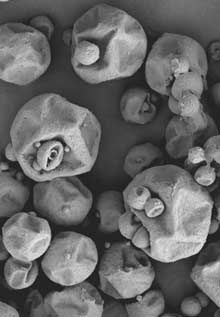 |
AC killers: These acrylic microcapsules are filled with a paraffin wax that can absorb heat from buildings.
Credit: Peter Schossig |
Building materials that absorb heat during the day and release it at night, eliminating the need for air-conditioning in some climates, will soon be on the market in the United States. The North Carolina company
National Gypsum is testing drywall sheets--the plaster panels that make up the walls in most new buildings--containing capsules that absorb heat to passively cool a building. The capsules, made by chemical giant
BASF, can be incorporated into a range of construction materials and are already found in some products in Europe.
The "phase-change" materials inside the BASF capsules keep a room cool in much the same way that ice cubes chill a drink: by absorbing heat as they melt. Each polymer capsule contains paraffin waxes that melt at around room temperature, enabling them to keep the temperature of a room constant throughout the day. The waxes work best in climates that cool down at night, allowing the materials inside the capsules to solidify and release the heat they've stored during the day.
In some southern European climates, for example, the materials absorb enough heat during the day to save 20 percent of the electricity needed for air-conditioning. In northern Europe, where nighttime temperatures are cooler, a building incorporating the materials may not need an air conditioner at all, says Peter Schossig, an engineer at the Fraunhofer Institute in Munich, Germany, whose research group worked with BASF to develop the capsules.
The work is part of a push in the construction industry toward greener building materials that help maintain comfortable temperatures without using electricity. According to the U.S. Energy Information Administration, buildings consume more than 70 percent of the electricity generated in America, and about 8 percent of that is used for air-conditioning in homes and offices. Widely used lightweight construction materials including wooden framing and drywall enable contractors to put up buildings rapidly, but they don't store much heat, so temperatures inside fluctuate throughout the day.
Phase-change materials offer a way to add thermal mass to lightweight building materials, says Leon Glicksman, professor of building technology and mechanical engineering at MIT. Since the 1950s, several companies have tried to develop passive cooling systems that take advantage of phase-change materials. But they had limited success because it's difficult to incorporate these new materials into existing building substances.
BASF makes the microcapsules by rapidly beating melted wax into hot water. Since wax and water repel one another, the wax forms small droplets. When the researchers add acrylic precursors to the mix, the repulsion between wax and water drives them to coat the droplets' surface. Finally, they add a catalyst to form an acrylic polymer shell around the wax. The resulting wet mixture can then be added to the powder that's used to make drywall or dried out and incorporated into other construction materials, including concrete and plasters.
Chemical giant DuPont also makes encapsulated phase-change materials and has incorporated them into heat-absorbing panels that it markets in Europe. BASF's strategy is a little different: the company sells the capsules to other companies to incorporate into a range of building materials, including ceiling panels, aerated concrete blocks, and drywall. Based on German electricity prices and climate conditions, a study conducted by BASF estimated that a family home made with plaster that incorporated 360 grams of the phase-change material (at a cost of $4,883) would save enough electricity to recoup the cost within five years.
National Gypsum is working with the National Renewable Energy Laboratory and California's Emerging Technologies Coordinating Council to field-test its heat-absorbing panels, which will be marketed under the name Thermalcore. The panels are made by mixing the BASF microcapsule-water solution with gypsum, the mineral used to make drywall. The paraffins used by BASF can be tailored to melt at different temperatures; those in National Gypsum's panels liquefy at 22.8 ºC (about 73 ºF). According to the company, the panels can store 22 British thermal units per square foot.
National Gypsum will take at least a year to test the panels' performance through all four seasons before bringing them to market. A spokesperson says the company may reformulate the panels to include more or less of the capsules, depending on how they perform in the climate of the western United States. Data from the field trials will also be used to model how much the panels help reduce energy consumption.
So far, the heat-absorbing capsules have only been tested in passive systems. But they could also be used in active systems in warmer climates, says MIT's Glicksman. "In commercial buildings, you could run the air conditioner at night when electricity is cheaper and use the phase-change materials to maintain lower temperatures during the day," he says. Schossig says his research group and BASF are gathering data from experimental active systems.
Copyright Technology Review 2010.

